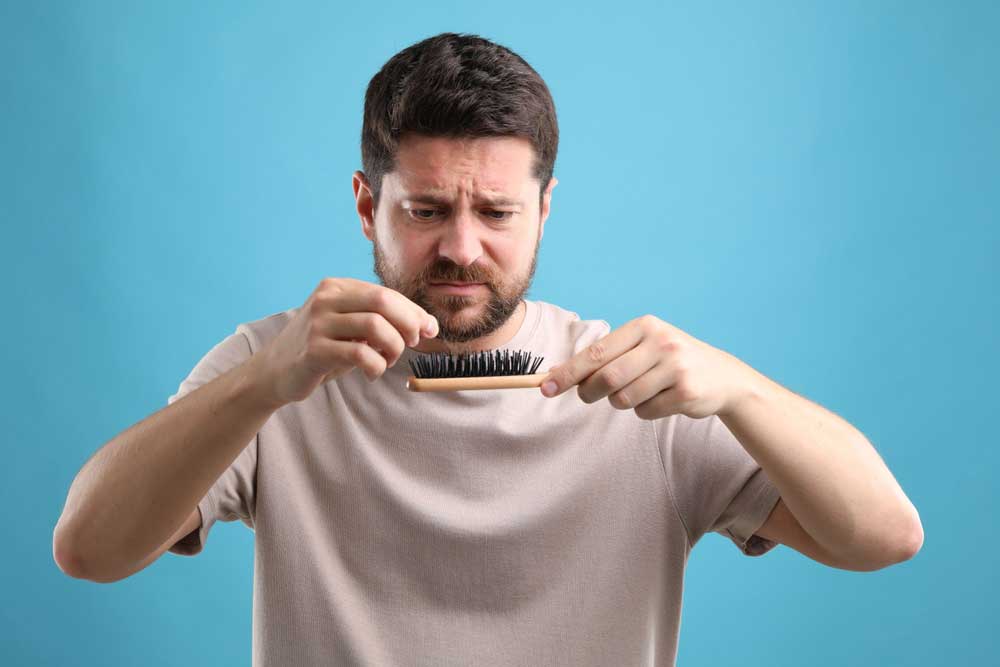At Hair By Dr. Max, Restoration Center, we are attentive to all your hair restoration needs and are happy to offer other solutions to help you achieve thicker, fuller hair. Hair By Dr. Max, Restoration Center offers Hair Boost, which are topical solutions formulated with DHT blockers and other ingredients . Our Hair Boosts have been clinically proven to boost your hair follicles and increase hair density. Because the solutions are applied topically to the skin, there are also less systemic side effects. Our Hair Boosts come in solutions for use by both men and women; both formulas are prescription-only and do require a formal consultation with Dr. Max. Come in today and learn more about which non surgical hair loss treatment might be best for you. In the following article, we will go over the ingredients in our hair boost topical solution for men and women who suffer from hair loss. Keep in mind, it is always best to consult your doctor or a hair specialist before taking any medications. If you have any questions, please feel free to call us at 954-945-2909.
1. Finasteride
Finasteride was originally used to treat men with benign prostatic hyperplasia (BPH), but a side factor of the medication included combating male pattern hair loss, also called androgenetic alopecia. It may be used alone or in combination with other medicines such as an alpha-blocker to treat BPH. For men with hair loss, finasteride will increase the number of scalp hairs but will not increase the amount of body hair.
2. Minoxidil
Originally created to treat high blood pressure, soon after that it was discovered that Minoxidil had properties that promote hair growth in patients. It is effective in helping promote hair growth in people with androgenic alopecia regardless of sex. About 40% of men experience hair regrowth after 3–6 months. Minoxidil must be used indefinitely for continued support of existing hair follicles and the maintenance of any experienced hair regrowth. The mechanism by which minoxidil promotes hair growth is not fully understood. Minoxidil is a potassium channel opener, causing hyperpolarization of cell membranes. Theoretically, by widening blood vessels and opening potassium channels, it allows more oxygen, blood, and nutrients to the follicles. This may cause follicles in the telogen phase to shed, which are then replaced by thicker hairs in a new anagen phase.
3. Tretinoin
Tretinoin is a Vitamin A analog and a topical form of retinoic acid. It is sometimes prescribed as a subsidiary treatment to enhance the efficacy of Minoxidil, such as in Rogaine. Some of the retinoids produced much greater changes in the levels of cellular retinoic acid-binding protein. And these compounds also demonstrated a much stronger influence on the hair life cycle. Similar events occur when using Minoxidil. This seems to support the ability of retinoids to have some ability to support new hair growth. Experts believe that certain retinoids are able to regulate and promote the proliferation of cells as well as processes which cause them to differentiate. It may also cause blood vessels to proliferate as well. These dynamics are important for the promotion of hair growth.
4. Melatonin
It’s the only treatment FDA-approved for female pattern baldness, or androgenetic alopecia. The telltale sign of androgenetic alopecia is an overall thinning of your hair. For many women, hair loss happens on the top or the front of the head. In most women, minoxidil slows down or stops hair loss. And in up to a quarter of the women who take it, minoxidil can actually encourage new hair to grow. It works best when you use it as soon as you notice that you’re losing hair. Minoxidil is thought to induce an early anagen phase when it’s applied to your scalp, meaning it can cause hair follicles to go through the rest of the growth process prematurely before starting to grow again.
This is why some people experience hair shedding when they first start using minoxidil. As hair follicles go through the growth process and enter into the anagen phase, old hairs can fall out in large numbers, making it seem as if you’re losing more hair than normal. Minoxidil also prolongs the anagen phase, leading to increased hair length and diameter.
5. DMSO
DMSO is a prescription medicine and dietary supplement. It can be taken by mouth, applied to the skin (used topically), or injected into the veins (used intravenously or by IV). DMSO is taken by mouth, used topically, or given intravenously for the management of amyloidosis and related symptoms. Another commonly associated substance with DMSO is MSM (methylsulfonylmethane). DMSO is used topically (applied to the skin). MSM is sold as a dietary supplement, either alone or in combination with other ingredients such as glucosamine. It has shown to aid in the promotion of hair growth in patients who have used it.
You Might Also Like To Read
We lose about 100 hairs per day…Learn Why
WHAT MAKES AFRICAN AMERICAN HAIR TRANSPLANTS UNIQUE?
Due to recent advancements in technology, the FUE approach has become a very viable option…
5 WAYS STRESS CAUSES HAIR LOSS
It’s best to learn these signs sooner than later!


